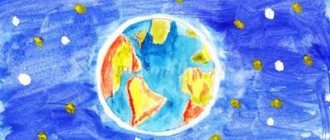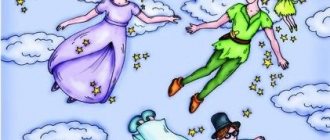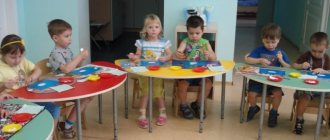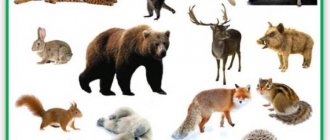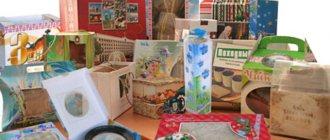Summary of an educational lesson in a preparatory group on the topic “History of the Automobile”
Program content:
1. Strengthen children’s knowledge about modern transport.
2. Introduce children to the history of the development of road transport. 3. Systematize children’s knowledge about traffic rules and behavior on the street.
4. Develop children’s cognitive and mental activity: produce mental
operations (comparison, generalization); develop creative thinking.
5. Improve dialogic speech, enrichment and activation of vocabulary:
chariot, carriage, steam engine, “self-propelled car”, types of transport:
land, air, water, passenger, cargo, rail,
agricultural.
Material:
A panel with a set of pictures of various types of transport, drawings “History of road transport”, individual cards with a task (drawing by dots), a model of a city street, an exhibition of road transport.
Preliminary work:
1. Reading books by V. Zubkov “From Wheel to Robot”, “Machines Around Us”, “Great Discoveries”.
2. Lessons “Cave people”, “Giants of the past”, “Peasant farmstead”, “History of the wheel”.
3. Excursions along the city streets.
4. Making a “City Street” model.
Progress:
The teacher invites the children to the “transport museum”.
Listening to a tape recording (sounds and noises of the street, transport)
- What sounds and noises did you hear?
- Plane, train, cars - what is it?
— What types of transport do you know?
— What type of transport can you most often find in our city?
— Name the types of ground transport.
— In front of you is a panel and different types of transport. Find each car its place (working with panels)
-What is the difference between air transport and water transport?
What is the name of a vehicle that transports people?
What is the name of a vehicle that transports goods?
Panel truck what type of transport and why?
Machines, like people, have many different professions: loaders, postmen, orderlies, military personnel.
What are they for? Who created them?
Yes, thanks to the intelligence, talent and imagination of man, such a miracle technology was created.
Have you ever wondered if there were cars many years ago?
What did they look like?
Want to know how they came to be?
Many, many years ago, ancient people carried loads on themselves, dragged them along the ground. Then, in order to move the load, they began to place logs and push them with long poles. It was very difficult. And then man invented the wheel, which is where it all began. People built carts on solid wooden wheels. They were slowly dragged along the roads by bulls and oxen. In order to travel faster, horses began to be harnessed to the carts - and thus the chariot was born. The ancient Greeks inserted spokes into wooden wheels to make their carts lighter and faster. They rode chariots into battle, solemnly entered captured cities, and competed peacefully at the Olympic Games. But it was inconvenient to ride a chariot, because... it was unstable and could only be ridden while standing. Later, chariots were replaced by carriages. Four-wheeled, closed, they could transport many people and their things: luggage, mail. But the carriages could not travel long distances without stopping, because the horses were tired, they could not do without food and water, and people were also tired from the bumpy ride. A steam engine appeared. And the man called this unusual invention “car”, which means it moves itself – “self-propelled”. Such a car drives around the city, a copper boiler is suspended from it, and the driver sits on a bench and turns the steering wheel. It will drive a little and stop, which means the steam in the boiler has run out. No steam - the machine does not work. The driver had to get out of the car and work as a fireman - lighting the firebox and boiling water. Since then, such a driver-stoker began to be called a driver. Such a car was also inconvenient,
because was heated with wood, the boiler could explode, which created a danger for the driver and pedestrians. Therefore, the steam engine was soon replaced by the first car that had a motor and was fueled with gasoline. This car had different wheels:
two large rear wheels and one small front wheel. It could only be driven by one driver, who controlled the car using a handle. Later, the car got a roof, the wheels were made the same size, and there were four of them. For strength, the wooden wheels with spokes were covered with iron hoops, but there were no doors or glass, and they often broke. Gradually, cars began to have doors, windows,
they began to carry more passengers, but, most importantly, they put rubber inflatable tires on the wheels. Every year there were more and more gasoline cars. Their appearance changed, the design improved, the speed of movement increased, the cars became more convenient for both the driver and passengers.
Imagine that you are design engineers, creating a car of the future. What will it be like? I hope that in the future we will see such cars on our roads.
— Guys, you know that museum employees often have to unravel the secrets of ancient objects, things, paintings. It seems to me that this envelope holds some kind of secret.
Let's try to solve it? Here are encrypted pictures. (Task – connect the dots.)
Our tour of the museum has ended, and I invite you to rest.
Physical exercise.
— The continuous flow of traffic on the roads creates emergency situations. Let’s go to the “City Street” layout and see what emergency situations have arisen here. Find them.
Situations: cyclist - child entered the roadway,
a woman with a stroller crosses the street at a red traffic light,
the road sign was installed incorrectly,
a girl on roller skates clings to a moving vehicle,
children play ball on the sidewalk.
— Today we visited the “transport museum” and learned about the history of the car.
Summary of GCD "What do people drive"
Lesson notes for the first junior group “What people drive”
Lesson notes for the first junior group No. 11. Educator: Pevtsova Daria Gennadievna.
Tasks
. Introduce children to various types of transport, teach them to distinguish by appearance, name parts, colors. Exercise children to run in one direction without bumping into each other. Perform movements according to the teacher’s verbal signal.
Preparation for class
. Toys: steam locomotive, car, plane, squirrel, hedgehog, hare. Napkin.
Progress of the lesson
. Children sit on chairs.
Educator
puts on the table, covered with a scarf, a car, an airplane, a steam locomotive.
Educator
. Children, I have a handkerchief on my table, and there’s something hidden under it, do you want to know what’s there?
Children
. Yes! They are called toys.
Educator
He lifts his handkerchief and looks at the car, locomotive and airplane together with the children.
Educator.
About them, in one word we can say this is transport.
Educator
. What is transport needed for? Let's all repeat this word "transport" together.
Children.
To travel, to carry cargo.
Educator
. Now you and I will play the game “Guess what’s missing.” I’ll cover our toys with a napkin and put one away. And you tell me what is not. The teacher quietly removes one toy, opens the napkin, and the children guess what is missing. Along the way, he gets settled with the children, the train sped off, the plane took off, the car drove away.
Educator
. Children, we have a train, but what does it lack?
Children.
Carriages
Educator
. Let us attach trailers to our locomotive
(children play with a train with carriages - they roll it along the railway)
Educator
. How does the locomotive sound? (Too-too-too)
I'm going, I'm going, I'm going here and there
And the carriages knock, and the carriages talk
So so so. So so so.
Educator
. Our train has rushed to the airport, get off. At the airport, planes are preparing to fly. We are airplanes, we start the engines (children make circular movements with their arms in front of their chests). The engines started humming oo-oo-oo. the planes showed their wings, shook them, and flew. Children fly around the room, saying the words together with the teacher:
We'll build the plane ourselves
Let's fly over the forests
Let's fly over the forests
And then we'll go back to mom.
Educator
. The planes are landing, we have landed, we have a rest, we start the engines, we fly (the words are pronounced again), we land on the chairs.
Educator. Children, while we were flying, little animals came to visit us: a bunny, a squirrel and a hedgehog. They told me that they wanted to go for a ride in the car. Our car is beautiful - the cab is yellow, the body is red, and the wheels are black.
re-enactment
. A car pulled up, the cab was yellow, the body was red, and the wheels were black. The animals have never seen such a beautiful car. And they wanted to ride it. A bunny jumped into the back, a squirrel jumped in, and the hedgehog jumped and jumped, but couldn’t jump to the back, his legs were short. I sat down and cried bitterly, I really wanted to go for a ride in the car. The squirrel and the bunny looked at him. They felt sorry for the hedgehog, a squirrel jumped out of the back, took the hedgehog, sat him down, and the bunny gave his paws to the hedgehog and the hedgehog ended up in the back, the squirrel jumped into the back again, and the car drove off. The cab is yellow, the body is red, and the wheels are black. The car goes forward and backward, forward and backward, the animals are having fun. The car stopped, the squirrel jumped off, the bunny jumped off, and they helped the hedgehog get out. Happy animals, we took a ride in the car. The cab is yellow, the body is red, and the wheels are black.
